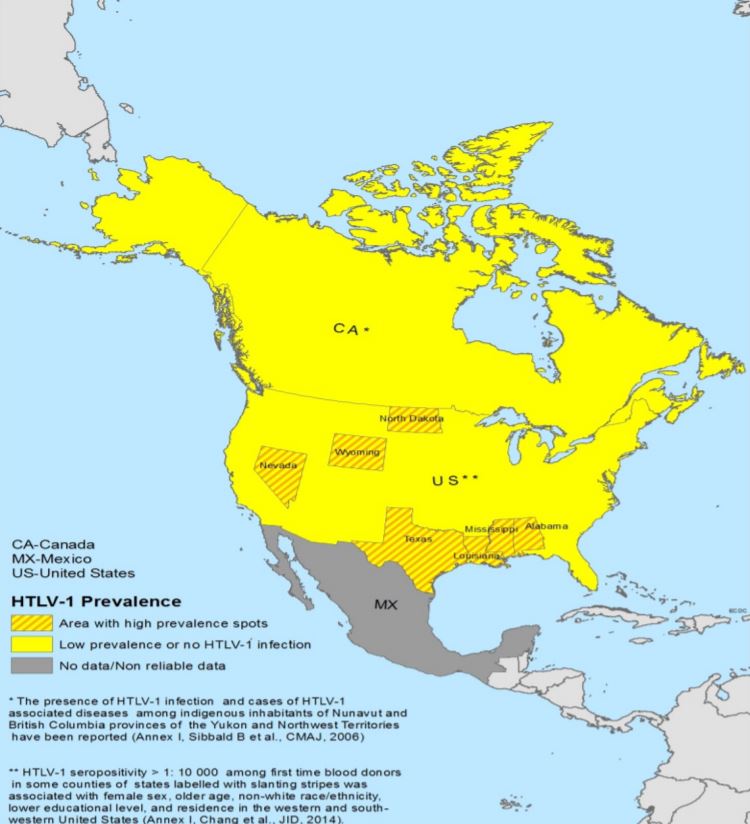Adult T-cell leukemia epidemiology and demographics
|
Adult T-cell leukemia Microchapters |
|
Diagnosis |
|---|
|
Treatment |
|
Case Studies |
|
Adult T-cell leukemia epidemiology and demographics On the Web |
|
American Roentgen Ray Society Images of Adult T-cell leukemia epidemiology and demographics |
|
Adult T-cell leukemia epidemiology and demographics in the news |
|
Blogs on Adult T-cell leukemia epidemiology and demographics |
|
Risk calculators and risk factors for Adult T-cell leukemia epidemiology and demographics |
Editor-In-Chief: C. Michael Gibson, M.S., M.D. [1]; Associate Editor(s)-in-Chief: Haytham Allaham, M.D. [2]; Grammar Reviewer: Natalie Harpenau, B.S.[3]
Overview
The majority of adult T-cell leukemia cases are reported in Japan, the Caribbean, South America, and Africa. In southern Japan, the age-adjusted incidence rate of adult T-cell leukemia is approximately 6.6 per 100,000 individuals. The incidence of adult T-cell leukemia increases with age, and the median age at diagnosis is 57 years. Males are more commonly affected with adult T-cell leukemia than females. The male to female ratio is approximately 1.4 to 1. Adult T-cell leukemia usually affects individuals of the African American, Latin American, and Asian race. Caucasian individuals are less likely to develop adult T-cell leukemia.
Epidemiology and Demographics
Prevalence
- Human T-Lymphotropic Virus type 1 (HTLV-1) infects at least 5–10 million people worldwide.[1]
- HTLV-1 is endemic to Central Australia and infection prevalence in this region ranges from a low of 7200 per 100,000 to a high of 13,900 per 100,000 of socially disadvantaged indigenous adults.[2][3][4]
- In Australia, HTLV-1 carriers were first reported among indigenous residents of remote desert communities in 1988.[5]
- Breastfeeding is thought to play an important role in transmission of HTLV-1 in indigenous Australian population.[6]
- In the US, adult T-cell leukemia is considered a rare disease that mainly tends to develop among African American intravenous drug abusers.[7]
- The majority of adult T-cell leukemia cases are reported in Japan, the Caribbean, South America, and Africa.



Incidence
- Among HTLV-1 carriers in high prevalence regions such as Central Australia, Japan and Carribean, adult T-cell leukemia/lymphoma (ATLL) will ultimately develop in 1-5% of infected individuals.[8]
- In southern Japan, the age-adjusted incidence rate of adult T-cell leukemia is approximately 6.6 per 100,000 individuals.[9][10][11]
- The annual incidence of adult T-cell leukemia development among HTLV-1 carriers is approximately 60 per 100,000 individuals.
Age
- The incidence of adult T-cell leukemia increases with age,and the median age at diagnosis is 57 years.[7]
- The age of onset for adult T-cell leukemia differs across geographical regions, such as:
- The median age at diagnosis in Japan is 60 years.
- The median age at diagnosis in Central America is 40 years.
Gender
- Males are more commonly affected with adult T-cell leukemia than females. The male to female ratio is approximately 1.4 to 1.[9][10][11]
- Females are more commonly affected with HTLV infection than males. However, the risk of adult T-cell leukemia development among HTLV male carriers is five fold higher than the risk of adult T-cell leukemia development among HTLV female carriers.
Race
- Adult T-cell leukemia usually affects individuals of the African American, Latin American, and Asian race.
- Caucasian individuals are less likely to develop adult T-cell leukemia.[9][10][11]
References
- ↑ "Clinical Associations of Human T-Lymphotropic Virus Type 1 Infection in an Indigenous Australian Population".
- ↑ Bastian I, Hinuma Y, Doherty RR (July 1993). "HTLV-I among Northern Territory aborigines". Med. J. Aust. 159 (1): 12–6. PMID 8316104.
- ↑ "Clinical Associations of Human T-Lymphotropic Virus Type 1 Infection in an Indigenous Australian Population".
- ↑ Einsiedel L, Cassar O, Bardy P, Kearney D, Gessain A (October 2013). "Variant human T-cell lymphotropic virus type 1c and adult T-cell leukemia, Australia". Emerging Infect. Dis. 19 (10): 1639–41. doi:10.3201/eid1910.130105. PMC 3810736. PMID 24047544.
- ↑ May JT, Stent G, Schnagl RD (July 1988). "Antibody to human T-cell lymphotropic virus type I in Australian aborigines". Med. J. Aust. 149 (2): 104. PMID 2839756.
- ↑ Einsiedel L, Cassar O, Bardy P, Kearney D, Gessain A (October 2013). "Variant human T-cell lymphotropic virus type 1c and adult T-cell leukemia, Australia". Emerging Infect. Dis. 19 (10): 1639–41. doi:10.3201/eid1910.130105. PMC 3810736. PMID 24047544.
- ↑ 7.0 7.1 Mahieux R, Gessain A (2007). "Adult T-cell leukemia/lymphoma and HTLV-1". Curr Hematol Malig Rep. 2 (4): 257–64. doi:10.1007/s11899-007-0035-x. PMID 20425378.
- ↑ Verdonck K, González E, Van Dooren S, Vandamme AM, Vanham G, Gotuzzo E (April 2007). "Human T-lymphotropic virus 1: recent knowledge about an ancient infection". Lancet Infect Dis. 7 (4): 266–81. doi:10.1016/S1473-3099(07)70081-6. PMID 17376384.
- ↑ 9.0 9.1 9.2 Satake M, Yamada Y, Atogami S, Yamaguchi K (2015). "The incidence of adult T-cell leukemia/lymphoma among human T-lymphotropic virus type 1 carriers in Japan". Leuk Lymphoma. 56 (6): 1806–12. doi:10.3109/10428194.2014.964700. PMID 25219595.
- ↑ 10.0 10.1 10.2 Iwanaga M, Watanabe T, Yamaguchi K (2012). "Adult T-cell leukemia: a review of epidemiological evidence". Front Microbiol. 3: 322. doi:10.3389/fmicb.2012.00322. PMC 3437524. PMID 22973265.
- ↑ 11.0 11.1 11.2 Adult T-cell leukemia/lymphoma. Wikipedia (2015) https://en.wikipedia.org/wiki/Adult_T-cell_leukemia/lymphoma Accessed on November, 3 2015